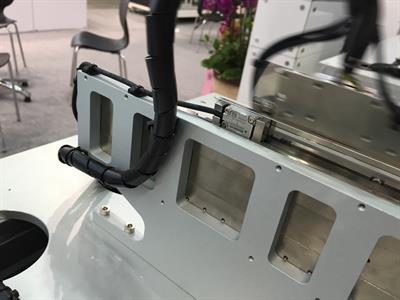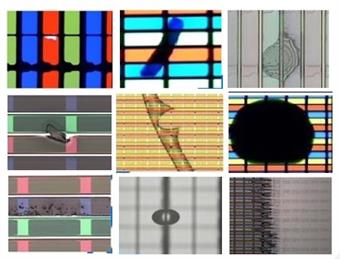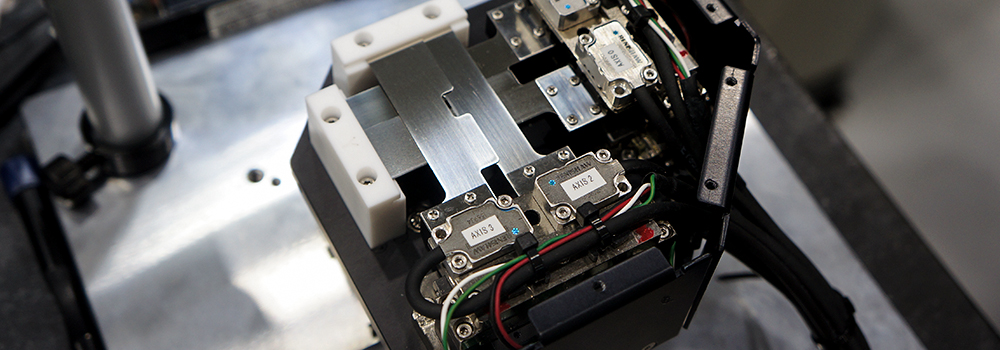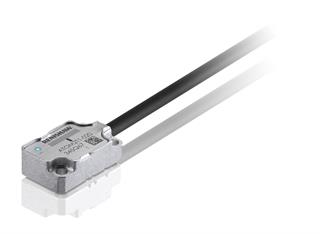ATOM™微形光學尺系統在面板製造業的應用
韓國的面板製造技術近年在全球業界中一直處於領先地位,很多先進面板製程如OLED、AMOLED等都是韓國廠家率先把技術應用在大批量生產上。雖然面板產能規模和市場目前被其他國家地區的製造商奮起直追,不過大部份生產設備的核心技術仍然掌握在韓國設備廠商手上。一塊面板的製造涉及多個複雜製程,每道玻璃基板製成後都需要經過檢測設備找出所有瑕疵和缺陷,再經過雷射放射作修複或電路重整,才能進入下一個製程。韓國的面板製造技術近年在全球業界中一直處於領先地位,很多先進面板製程如OLED、AMOLED等都是韓國廠家率先把技術應用在大批量生產上。雖然面板產能規模和市場目前被其他國家地區的製造商奮起直追,不過大部份生產設備的核心技術仍然掌握在韓國設備廠商手上。一塊面板的製造涉及多個複雜製程,每道玻璃基板製成後都需要經過檢測設備找出所有瑕疵和缺陷,再經過雷射放射作修複或電路重整,才能進入下一個製程。TPC Motion(以下簡稱TPC) - 韓國知名運動控制元件生產商開發的光學間隙平臺(Optical Slit),採用多軸Renishaw ATOM系列微形直線光學系統,為面板修補設備提供精確的雷射整形調控方案。
面板缺陷修補
面板在整個生產過程中不可避免地會出現缺陷,缺陷一般分為幾大類:一種是面板上的電路出現短路或開路,利用雷射重新焊接或切斷。另一種是點缺陷,因粉塵、刮傷和其他污染物在面板上造成的亮點或暗點。
對於亮點的處理,透過雷射加工把面板色層阻碳化變暗點,而對於暗點缺陷,雷射把聚焦在多餘的鉻點上,使之汽化而去除了暗點。另外還有在水平和垂直方向出現的亮線或暗線等缺陷,都是利用雷射加工作修補。

The ATOM series meets all of our main requirements for a high-performance, low-noise and light-weight miniature encoder system.Direct comparison with competing brands has demonstrated beyond doubt that ATOM is indeed best-in-class.Renishaw's delivery lead-times and after-sales support have also proven to be excellent.
TPC Motion (TPC) (South Korea)
Panel defect repair

As modern FPD manufacturing techniques become more complex and difficult, panel defects are increasingly likely.Robust inspection and repair procedures have been developed to ensure that errors, where they do occur, have minimal effect on display quality.Processes needing repair operations in liquid crystal display (LCD) manufacturing, for instance, include those involving thin film transistor (TFT) substrates, colour filter (CF) substrates and TFT / CF alignment (cell assembly).
Damage to any one of the millions of transistors within the LCD panel may leave a sub-pixel permanently on or off, creating a tiny dark or bright spot on the display.Broken or shorted TFT data lines are often the cause of bright / black line defects.Repair structures integrated into the TFT layer allow white pixel defects to be turned to ‘black' or ‘dull' by irradiation with a laser.The laser is used in ablation / welding and is focused on the defect to either vaporize it or to create new contacts in the case of TFT repair.The spot-size (diameter) of the laser beam needs to be carefully controlled so as to encompass the defect but leave the normal substrate around it undamaged.Precise manipulation of the laser aperture, in the range of 5 – 50 microns (µm) in diameter, is vital to ensure successful panel repair and improved process yield.
Laser beam shaping
In the FPD repair process, the precise position of the laser beam on a panel substrate is controlled by a scanning mirror, or similar, while the substrate sits on an XY air-bearing stage.The aperture stop lies between the laser source and the intended target.Depending on the application, changes may be made to the laser beam shape, spread (divergence) or even intensity in order to meet process requirements.TPC's variable aperture stop design is novel for FPD repair as objective-lens systems are typical in this application.One advantage of a mechanically adjusted aperture is that laser spot sizes can be precisely controlled to within 1 µm or less, the typical feature size of 10th generation devices, which allows very accurate control of the beam spread.
Mr Hyun-Joo Hwang, director of TPC Motion, explains:“The laser aperture stop consists of four moving vanes arranged in crossed pairs.Each vane is driven by an individual voice coil motor with a maximum travel of only 2 mm.

All four voice coil motors are equipped with an ATOM encoder system for position feedback control.For this application, we selected the ATOM encoder with 50 nm resolution and RTLF tape scale.The accuracy of ATOM allows us to precisely control aperture sizes ranging from 5 x 5 µm to 50 x 50 µm.Before attempting to repair a defect, the aperture size is pre-set and then remains unchanged until the next repair operation."
Miniaturised design

TPC designed its aperture stop assembly to be as compact as possible, in order to fit inside a small imposed footprint.Clearly, consideration of the physical size of the chosen encoder system was essential to meet this criterion.
Mr Hwang continues:“The laser repair tool rapidly tracks back and forth across the panel to the location of every defect, which necessitates a light weight design to maximise throughput.The aperture assembly accommodates four voice coil motors, each with an ATOM encoder, all enclosed within an area of approx. 100 mm square.ATOM's best-in-class feedback performance provides improvements in aperture control, whilst the low mass (<4 g) of the readhead ensures that overall design weight remains uncompromised.”
ATOM's miniature readhead is only 7.3 mm x 20.5 mm x 12.7 mm (FPC cable variant) and is ideal for applications with limited space.
High-repeatability and high-stability
During defect repair with a laser, the size of the laser aperture must be fixed and stable between adjustments by the operator.This requires that the encoder outputs have minimal noise, such that each vane holds its position, without wander, once in place.
TPC requires that aperture stop repeatability be maintained in the ±0.5 µm range, in order to limit unintentional damage to the surrounding substrate.
Mr Hwang concludes:"The ATOM series meets all of our main requirements for a high-performance, low-noise and light weight miniature encoder system.Direct comparison with competing brands has demonstrated beyond doubt that ATOM is indeed best-in-class.Renishaw's delivery lead-times and after-sales support have also proven to be excellent.”

TPC's confidence is reflected by its recent development of a precision miniature linear motion stage which also incorporates the ATOM encoder.Potential applications of this new stage will include: semiconductor, FPD and others characterised by flexible, high-precision and compact production equipment.
About TPC
Tanhay Pneumatic Engineering Company (TPC) was founded in 1973 and is Korea's largest manufacturer of pneumatic equipment.TPC established its motion control division (TPC Motion) in 2009, specializing in the development of motion control-related products; including linear stage motors, servo motors, Cartesian coordinate robots, 3D printers, and other optical components.Customers include those in the semiconductor, FPD and printed circuit board (PCB) industries.In addition to the ATOM series, TPC employs Renishaw's TONiC™ optical encoder series and XL-80 laser interferometer for quality checks.



